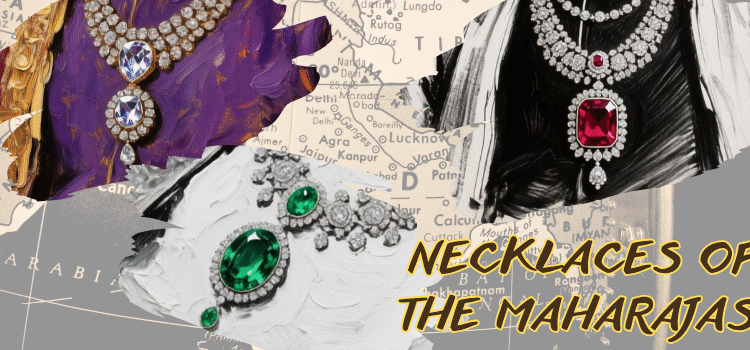The maharajas of India were known for their unmatched grandeur, regal lifestyles, and lavish displays of wealth. Among their most prized possessions were their necklaces — magnificent pieces of jewelry that reflected not only immense personal wealth but also royal power, taste, and prestige. These necklaces, often adorned with some of the world’s most precious gemstones and diamonds, became symbols of authority and were passed down through generations as part of the royal treasury.
Most royal necklaces of India were designed to highlight a single extraordinary precious stone in the center — a large ruby, sapphire, emerald, or diamond that often had its own fascinating story. These gems were sourced from far corners of the world: rubies from Burma (now Myanmar), sapphires from Kashmir, emeralds from Colombia, and diamonds from the legendary Golconda mines of India. It was always the most famed origin that was sought after, when meticulously picking the center stone for necklaces to be worn by the Maharajas.
The central stone would be surrounded by numerous smaller gems, intricately set in gold and embellished with enamel or pearls. The craftsmanship of these pieces was exquisite, reflecting centuries of Indian jewelry-making traditions perfected by skilled artisans working under royal patronage. Designs for royal jewels changed over time, this reflected a fusion of styles from across the globe.
For the maharajas, such necklaces were not mere ornaments — they were expressions of divine power and royal legitimacy. Wearing them at coronations, royal ceremonies, and diplomatic meetings projected wealth and influence. Some necklaces were also believed to bring good fortune or divine protection to their wearers, especially when they contained sacred gems like rubies (symbolizing the sun and royalty) or emeralds (associated with prosperity and wisdom).
Because of their immense value, these necklaces became targets for thieves, invaders, and even rival rulers. Throughout India’s history, the lure of royal jewels often led to wars and political intrigue. The plunder of royal treasuries by invading forces was common, and necklaces with enormous gems often vanished during such turbulent times. Some were seized by colonial powers or auctioned abroad when princely states lost their autonomy. A few resurfaced centuries later in European museums or private collections, while others disappeared entirely, leaving behind only legend.
HISTORIC NECKLACES
Several historic necklaces stand out in India’s royal heritage. The Patiala Necklace, crafted in the 1920s for Maharaja Bhupinder Singh of Patiala, is among the most famous. Made by Cartier, it originally featured nearly 3,000 diamonds, including a staggering 234.65-carat yellow De Beers diamond at its center — one of the largest diamonds ever mounted on jewelry. The necklace was eventually dismantled, and some parts were lost, but it remains a powerful symbol of royal opulence.
The treasury of the Maharaja’s of Kashmir, included some fine blue sapphires with an origin from the same region. Recent reports have mentioned the sighting of the Zanskar Crown Sapphire. The big cushion blue Kashmir sapphire is believed to weigh over 170 carats, the gem apparently boasts of the finest Kashmir sapphire color – an intense velvety blue. The sapphire was proudly positioned, as the center stone in an exorbitantly valued necklace worn by Maharaja Pratap Singh of Kashmir. It is widely accepted that this royal necklace no longer exists. The Maharaja himself, sold the big blue sapphire to a European collector – this was around 1920. Funds were to be allocated for various development projects (in Kashmir) – Maharaja Pratap Singh was committed to develop vital sectors that included, transport, health and education in the Kashmir region.
Another legendary piece was the Nizam of Hyderabad’s Diamond Necklace, part of the immense Nizam treasury reputed to be one of the richest in the world. This necklace, set with Golconda diamonds and Colombian emeralds, exemplified understated elegance combined with unmatched gem quality. The Baroda Pearl Necklace, owned by the Gaekwad royal family of Baroda, was another masterpiece featuring seven strands of natural pearls complemented by diamond spacers.
STORIES REFLECT REALITY
These historic necklaces tell stories of power, artistry, and shifting fortunes. While they dazzled the courts of India’s great maharajas, they also witnessed the turbulence of empire, conquest, and colonialism. Today, they survive as glittering reminders of a bygone era — when India’s royals ruled in splendor, and a single necklace could represent the glory of an entire kingdom.




























